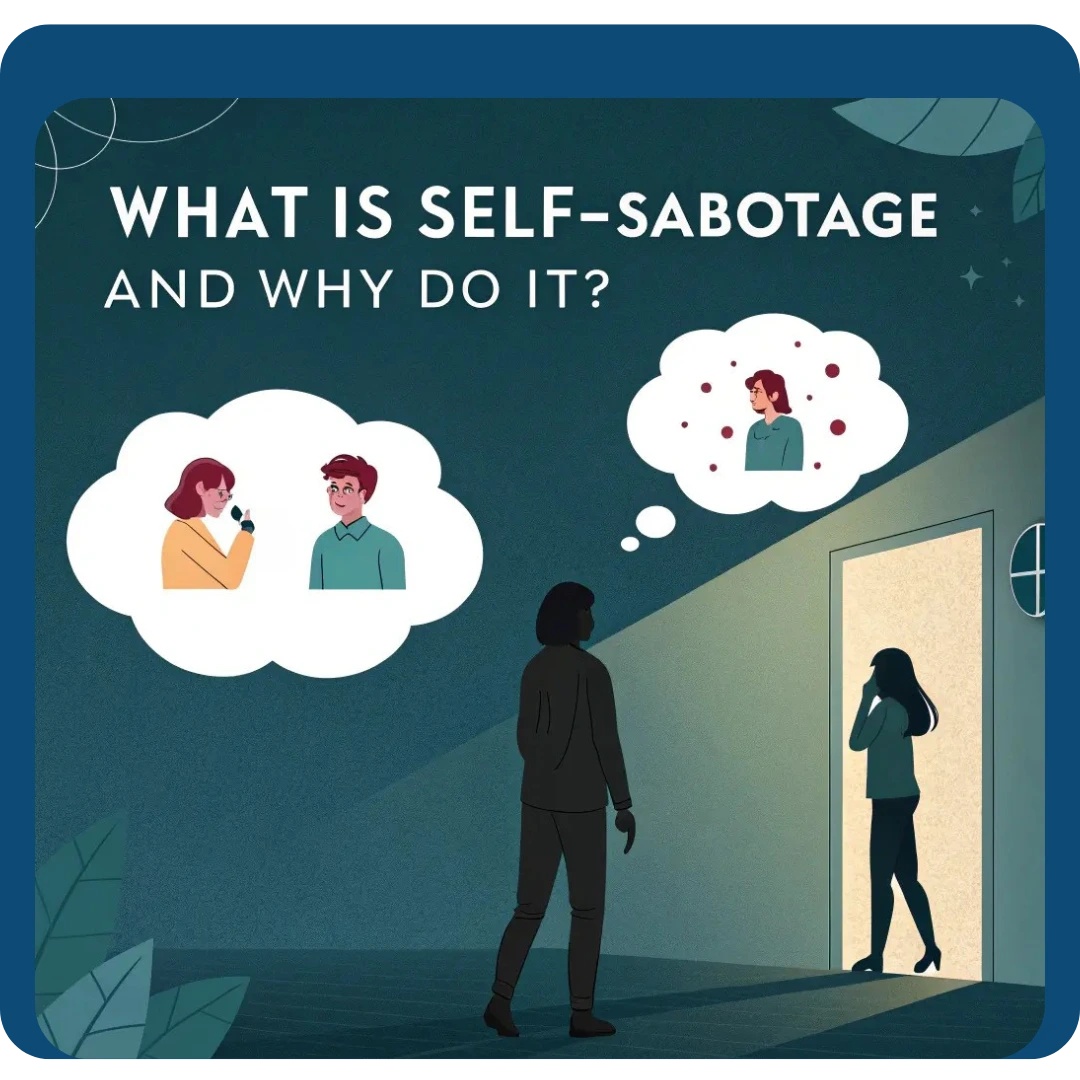What Is Self-Sabotage and Why Do We Do It?
We often dream of success, happiness, and peace of mind, but sometimes we unknowingly stand in our own way. This hidden obstacle is known as self-sabotage. It is one of the most common yet least talked-about challenges that prevents people from living to their full potential. By understanding what self-sabotage is and why we do it, we can begin to break the cycle and create meaningful change in our lives.
What is Self-Sabotage?
Self-sabotage is the pattern of thoughts, actions, or behaviors that hold us back from achieving our goals. It shows up when we delay important work, give in to negative self-talk, or create unnecessary drama in relationships. Instead of moving forward, we unconsciously block our own progress.
Some common examples of self-sabotage include:
- Procrastination
- Overthinking decisions
- Comparing yourself with others
- Avoiding opportunities out of fear
- Engaging in unhealthy habits like overeating or overspending
The most striking part of self-sabotage is that it often feels automatic. Even when we want better results, we may act in ways that cause us to fail or stay stuck.
Why Do We Self-Sabotage?
Self-sabotage is not about laziness or lack of willpower. It usually comes from deeper psychological and emotional patterns. Here are some of the most common reasons why people engage in self-sabotage:
Fear of Failure
Many people avoid taking risks or pursuing new opportunities because they are afraid of failing. By sabotaging themselves, they create an excuse: “I didn’t really try, so failure doesn’t count.”
Fear of Success
Strangely, success can be just as scary as failure. With success comes more responsibility, visibility, and expectations. Some people sabotage themselves to stay in a comfort zone where they feel safe.
Low Self-Worth
When someone believes they do not deserve happiness or success, they unconsciously act in ways that confirm this belief. Negative self-image and lack of confidence often fuel self-sabotage.
Unresolved Trauma or Conditioning
Past experiences, childhood patterns, or unresolved emotional pain can shape the way we act today. If a person grew up being criticized or doubted, they may repeat these patterns by doubting themselves as adults.
Need for Control
Sabotaging a situation can give a false sense of control. Instead of waiting for external failure, some people prefer to cause it themselves, believing it hurts less when they are the ones to decide.
How to Recognize Self-Sabotage in Your Life
Awareness is the first step to breaking free from self-sabotage. You may be sabotaging yourself if you notice:
Constant procrastination even on tasks you care about
Negative self-talk such as “I can’t do this” or “I don’t deserve this”
Setting unrealistic goals and then feeling like a failure when you cannot achieve them
Starting strong on projects but losing momentum midway
Pushing away people who care for you
Recognizing these patterns is not about judging yourself. It is about gently noticing where you get stuck. Therapies like inner child healing or cognitive-behavioral therapy (CBT) can help uncover the underlying causes and support you in creating lasting change.
How to Overcome Self-Sabotage
Once you understand the reasons behind self-sabotage, you can begin to take steps toward healing. Some practical ways to overcome it include:
- Practice self-awareness: Keep a journal of your thoughts and behaviors. Notice triggers that lead to sabotage.
- Challenge negative beliefs: Replace self-critical thoughts with kinder, supportive ones.
- Set realistic goals: Break big goals into smaller, achievable steps to build confidence.
- Seek support: Therapy, coaching, or support groups can help uncover deeper patterns.
- Celebrate small wins: Acknowledge progress instead of waiting for perfection.
- Develop self-compassion: Treat yourself as you would treat a close friend—with patience and encouragement.
By making small changes consistently, you can slowly shift from sabotage to self-support.
Conclusion
Self-sabotage may feel like a hidden enemy, but it is not permanent. By understanding why it happens—often due to fears, unresolved trauma, or feelings of low self-worth—and taking small, conscious steps, you can break the cycle and move toward a healthier, more empowered life. Remember, self-sabotage is not about weakness—it is a sign that some part of you is protecting itself from fear or pain. With compassion and patience, you can turn self-sabotage into self-growth.
Self-sabotage is when your thoughts, emotions, or actions unconsciously block your own progress. It shows up as procrastination, negative self-talk, or repeating unhealthy patterns.
People self-sabotage due to fear of failure, fear of success, low self-worth, unresolved trauma, or the need for control. It’s usually rooted in deeper emotional or psychological patterns.
You may be self-sabotaging if you constantly procrastinate, doubt yourself, push away opportunities, or set unrealistic goals that lead to disappointment.
No. Self-sabotage is not about laziness—it’s about deeper fears and conditioning. Many people who self-sabotage are hardworking but struggle with inner blocks.
Yes. Childhood criticism, unresolved emotional pain, or negative conditioning can create self-sabotaging patterns in adulthood.
You can overcome self-sabotage by practicing self-awareness, challenging negative beliefs, setting realistic goals, seeking support, and celebrating small wins.
Self-sabotage is not a diagnosis, but it is often connected with anxiety, depression, and unresolved trauma. Working with a therapist or coach can help.
Yes. With consistent awareness, self-reflection, and supportive practices, self-sabotage can be replaced with healthier behaviors and self-support.
The first step is awareness—acknowledging when and how you sabotage yourself. Once you see the pattern, you can start making conscious changes.
The timeline is different for everyone. With patience, self-compassion, and consistent practice, you can start noticing positive changes within weeks or months.





Pingback: Riyaa Rai
I appreciate the emphasis on self-compassion and realistic goal-setting. It’s a gentle reminder that growth is a process, not a sprint.
Such a compassionate take on self-sabotage! The section on unresolved trauma made me reflect on childhood experiences that I never connected to my adult patterns.
The examples of procrastination and overthinking really resonated with me. I’ve been stuck in that loop for years, and this gave me hope to start changing.
I loved how this post explained that self-sabotage isn’t laziness. Understanding it as a protective mechanism changes how I approach my habits.
Amazing breakdown of why we self-sabotage. I especially appreciate the practical steps for self-awareness and celebrating small wins. Makes the process feel achievable.
This article really helped me realize how often I unconsciously block my own progress. The part about fear of success hit me hard—I never thought I could be afraid of doing well!
As someone who has always been afraid of changes, reading this helped me understand why I cling to comfort zones. It’s not just fear — it’s self‑sabotage. Thank you for putting these ideas into words
I sometimes sabotage my own success by overthinking or doubting myself. Understanding these behaviors as self-sabotage gives me a starting point to change them gradually
I can relate to procrastinating on things that matter most because of fear of failure. This explanation of self-sabotage makes it feel like something I can actually work on
I often avoid asking for help even when I need it, and I didn’t know why. This post made me reflect that it’s self-sabotage from trying to stay in control.
’ve been guilty of overanalyzing social situations and second-guessing myself. Reading this makes me realize it’s a self-sabotage pattern, not just awkwardness
“I’ve caught myself saying ‘I’ll do it later’ over and over. Now I understand that fear and past habits are at play. It feels good to finally name it
I realized that overthinking and overplanning often stop me from taking real action. It’s comforting to know this pattern has a name and can be worked on
I recognize myself in the part where we set unrealistic goals and then feel like failures. Understanding this as self-sabotage is eye-opening and motivates me to be kinder to myself.
I never thought about how self-sabotage can show up in relationships. I sometimes push people away when I feel too vulnerable, and this article helped me understand why.
I often delay important tasks because I fear failing, even though I know I’m capable. Reading this made me realize it’s self-sabotage and not just procrastination.
This post pulled me up short — I see myself in many of the habits you described: perfectionism, overthinking, self-criticism. Good to know I’m not alone. I’m going to try noticing these behaviors without judgement, instead of punishing myself when they happen
This really resonated with me. I used to think my procrastination was laziness — now I see it might have been a form of self-sabotage. Eye-opening and very relatable.